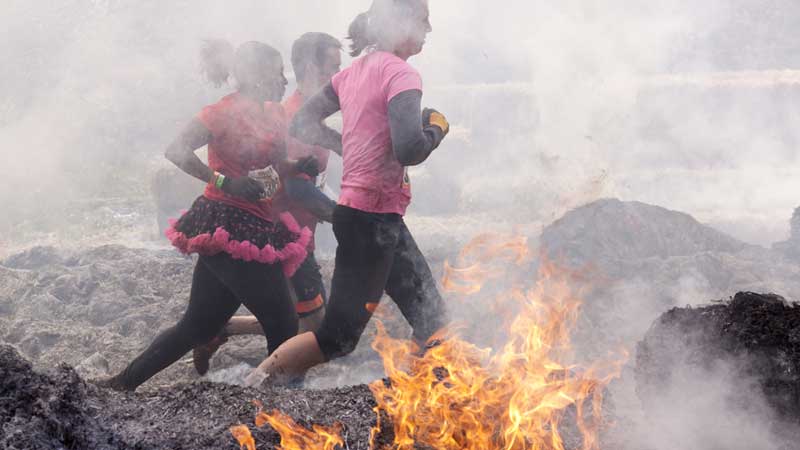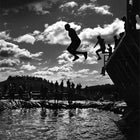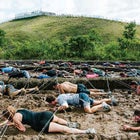Sam Mansfield and Mark Ballas met in the autumn of 2012 when the two were visiting an investment property near Fort Benning, Georgia. Ballas,┬áa former Army Special Forces soldier-turned-entrepreneur, had recently founded an adventure race called Green Beret Challenge, and Mansfield, a market researcher and consultant, had just started dabbling in mud races after years as an amateur triathlete. “We started to talk a little bit about ventures we wanted to get involved in in the future, and one that continued to come up was the obstacle course spaceÔÇöwhat is it in that industry that needs help?” The two quickly hit on the idea of a governing body for the sport, and on January 7 of this year, United States Obstacle Course Racing (USOCR) was born.┬á
At present, the company’s public face consists of a website, , that provides the mission statement and invites visitors to join the mailing list. But Mansfield told me USOCRÔÇöheavily modeled on USA TriathlonÔÇöwill begin signing up members as early as Valentine’s Day. As for event sanctioning, he said USOCR will be “certifying and working with endorsement programs this season.” He was not yet able to confirm any events that have agreed to participate in the sanctioning program, which will involve a standardized safety management planning process and on-site inspections by USOCR staff.┬á
Mansfield said the issue of event insurance was one of the early drivers for the development of USOCR. He speculated that current insurers of OCR events will begin pulling out of the industry as they develop a better understanding of the risks. When that happens, one of USOCR’s biggest assets will be a unique set of actuarial data compiled from sanctioned events that will help keep rates attuned to the actual risk and not the perceived risk. As Mansfield said, USOCR’s data will allow the industry to “define our risk instead of having our risk define us.”
For racers, membership will cost about $45 and will include discounts from partners like , excess injury insurance in the ballpark of $2,000 (the exact amount hasn’t been determined), and ranking in USOCR’s proprietary national system. Mansfield thinks injury insurance will be the main draw to potential members. “At this juncture in OCR that type of coverage doesn’t exist, so an injury at a race for a participantÔÇöthey’ve signed a waiver that basically means they’re not going to get anything beyond that injury.” With USOCR’s coverage, an ambulance trip for a broken ankle might not mean a broken bank account too.┬á
USOCR’s sales pitch sounds good, but the organization’s relevance to the sport will only be guaranteed if major race providers get onboard, and as far as we know, that hasn’t happened.
For now, USOCR isn’t targeting the million-plus “experience runners” who sign up for an obstacle race each year as a one-and-done challenge, though USOCR’s stamp of approval could be a powerful selling point when experience runners shop different races. The company is focused instead on devoted athletes who run several events each year, who are “looking to PR,” and who treat OCR as the “new endurance sport that they train for, the sport they love.” According to Mansfield, USOCR’s ranking system will allow those athletes to measure themselves against thousands of age-groupers across the country and could eventually become the basis for elite qualification as the sport matures. He expects a quick burst of 8-12,000 members in the first three months and up to 25,000 by the end of 2014, with an ultimate goal of about 100,000.
Ranking OCR presents more of a challenge than, say, triathlon, in which distances are fixed and the eventsÔÇöswimming, running, and cyclingÔÇöare always the same. Mansfield said USOCR has developed a “multiple weighting factor system . . . that permits you to run in any endurance race despite the disparities of distance, terrain, obstacle construction, negotiation style, and I can still give you the same style of ranking.” USOCR will simply “crank the algorithm, and out comes third place, or in Hobie Call’s case, first place.”
USOCR’s sales pitch sounds good, but the organization’s relevance to the sport will only be guaranteed if major race providers get onboard, and as far as we know, that hasn’t happened. As of now, race providers have their own insurance packages, and some, like Reebok-sponsored Spartan Race, have their own national ranking systems, too.┬á
Rob Dickens, Chief Operating Officer of Rugged Maniac, a leading OCR company that boasted over 100,000 runners in 2013, was skeptical of the entire outfit. “They’re not affiliated with any race companies, they don’t have any experience in the industry, and to me it just seems opportunistic,” he said. (We’ll leave aside the centrality of opportunism in business, and the particularly nasty strain of opportunism that has characterized the explosive growth of OCR.)
Dickens told me he doubts a governing body will get any traction. “I certainly don’t want a sanctioning body to come in to tell me how to run my event, and I would doubt that any of the other major companies do either,” he said. “We already do things the right way, our own way.” Regarding the controversial drowning death of Avishek Sengupta at a Tough Mudder last April, which I investigated for ║┌┴¤│ď╣¤═°, Dickens said, “I don’t see how a sanctioning body would have prevented that.”┬á
Aside from ensuring safety standards and insurance options for participants and race providers, Mansfield told me USOCR plans to make promotion of the sport one of its main focuses. Dickens said the majors don’t need it: most of them already have serious marketing clout and some even claim cult-like followings. “The only people who are going to go for this are the small companies who are struggling to survive,” Dickens said. “They need that marketing help to push them forward. I don’t see any of the bigger companies going for that.”
Dickens was also dismissive of USOCR’s ranking system. He told me Rugged Maniac offers timing, but only about 10 percent of racers go for it. “90 percent don’t care about their time, so the rankings might not mean all that much,” he said. Several other industry leaders, including Warrior Dash and Tough Mudder, are entirely untimed.
“We understand that some companies may choose not to partner,” Mansfield told me, responding to Dickens’s criticism. “But the evidence is clear… there are no enduring sports without supporting and regulatory bodies. OCR will be no different in this respect.”
When we first spoke, Mansfield sought to reassure race providers who worry that USOCR might be more of an opportunistic intruder than a true partner in growing the sport. “The race companies have to have say-so in how we operate. They need to be able to talk to us about what they want, what they envision, and what they need from their governing body,” Mansfield said. “Over the past year to fifteen months we have interviewed plenty of them and garnered a lot of perspective from them, and we will continue to need them to tell us exactly what this sport is going to be. So far that’s been a really great conversation.”┬á
Superhero Scramble’s Ace O’Connor said he was open to the idea of a governing body “if it makes sense for both the company and the participants.” As for USOCR, he said, “Seems like they are on the right path, and we will continue talks with them.” Savage Race’s Sam Abbitt said his company also thinks a governing body could be good for the sport. “Making something like this work will require buy in from all of the other big names in obstacle racing,” he said. “We probably will not join USOCR this year, but will certainly pay attention to their developments.”




